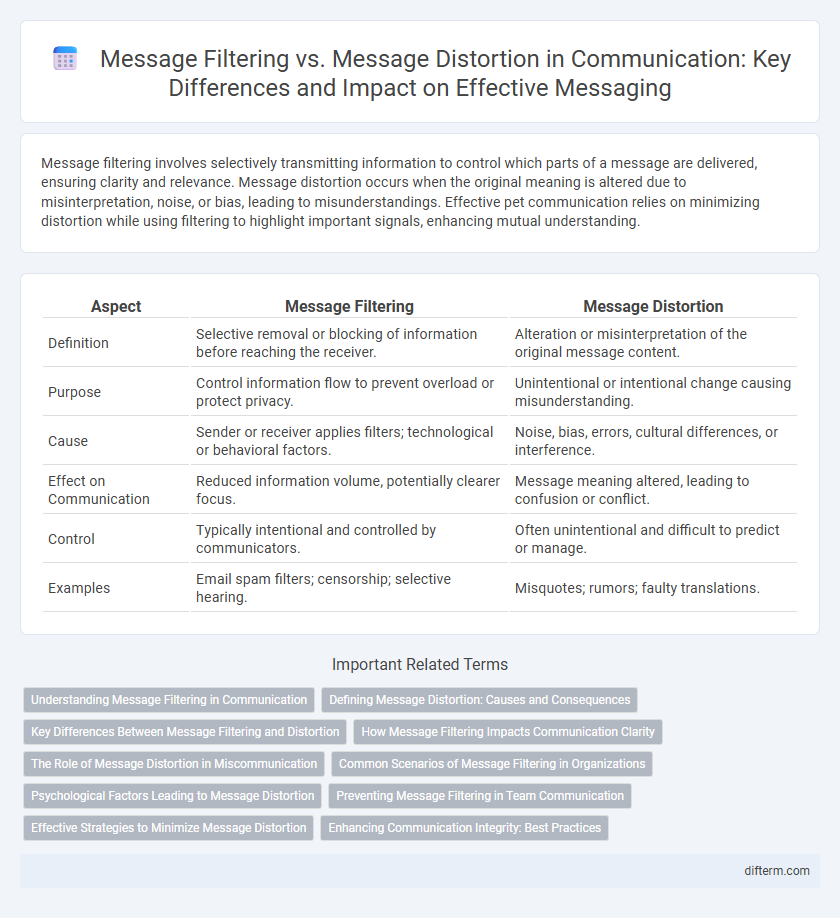Message filtering involves selectively transmitting information to control which parts of a message are delivered, ensuring clarity and relevance. Message distortion occurs when the original meaning is altered due to misinterpretation, noise, or bias, leading to misunderstandings. Effective pet communication relies on minimizing distortion while using filtering to highlight important signals, enhancing mutual understanding.
Table of Comparison
| Aspect | Message Filtering | Message Distortion |
|---|---|---|
| Definition | Selective removal or blocking of information before reaching the receiver. | Alteration or misinterpretation of the original message content. |
| Purpose | Control information flow to prevent overload or protect privacy. | Unintentional or intentional change causing misunderstanding. |
| Cause | Sender or receiver applies filters; technological or behavioral factors. | Noise, bias, errors, cultural differences, or interference. |
| Effect on Communication | Reduced information volume, potentially clearer focus. | Message meaning altered, leading to confusion or conflict. |
| Control | Typically intentional and controlled by communicators. | Often unintentional and difficult to predict or manage. |
| Examples | Email spam filters; censorship; selective hearing. | Misquotes; rumors; faulty translations. |
Understanding Message Filtering in Communication
Message filtering in communication involves selectively transmitting certain information while omitting or altering other parts, often due to personal biases, cultural differences, or organizational policies. This process can shape how the receiver perceives the message, potentially leading to incomplete understanding or misinterpretation. Recognizing message filtering helps improve clarity by encouraging transparency and feedback mechanisms in communication channels.
Defining Message Distortion: Causes and Consequences
Message distortion occurs when the original meaning of a communication is altered due to factors like noise, misunderstandings, and selective perception. Causes include physical distractions, emotional biases, and linguistic differences that interfere with accurate message transmission. This distortion can lead to misinterpretations, conflicts, and reduced effectiveness in both personal and organizational communication.
Key Differences Between Message Filtering and Distortion
Message filtering selectively blocks or allows information to pass based on relevance or criteria, preserving the original content's intent and meaning. Message distortion alters the original message by changing, exaggerating, or omitting details, leading to misinterpretation or misinformation. The key difference lies in filtering's role as a gatekeeper for clarity, whereas distortion modifies the message content, impacting communication accuracy.
How Message Filtering Impacts Communication Clarity
Message filtering enhances communication clarity by selectively transmitting relevant information, reducing noise and cognitive overload. It ensures that only essential data reaches the receiver, minimizing misunderstandings caused by irrelevant or extraneous content. Effective message filtering streamlines communication channels, fostering accurate interpretation and efficient information processing.
The Role of Message Distortion in Miscommunication
Message distortion plays a critical role in miscommunication by altering the original content of a message, leading to misunderstandings and confusion between parties. Unlike message filtering, which selectively emphasizes or omits information, distortion changes the meaning through factors such as noise, perception biases, or transmission errors. Accurately identifying and minimizing distortion is essential for enhancing the clarity and effectiveness of communication in both personal and professional contexts.
Common Scenarios of Message Filtering in Organizations
Message filtering in organizations commonly occurs through selective attention, where employees focus only on information relevant to their roles, potentially overlooking critical broader details. Hierarchical filtering often shapes communication flow, as managers prioritize or modify messages to align with organizational goals before passing them down. Noise and technological barriers also contribute to message filtering, causing incomplete or altered information to reach recipients, impacting decision-making and collaboration.
Psychological Factors Leading to Message Distortion
Psychological factors such as cognitive biases, emotional state, and preexisting beliefs significantly contribute to message distortion by altering the receiver's perception and interpretation. Unlike message filtering, which involves selective attention or omission based on relevance or interest, distortion occurs when internal psychological processes modify the message content. Understanding these psychological influences is crucial for improving communication accuracy and reducing misunderstandings.
Preventing Message Filtering in Team Communication
Message filtering occurs when important information is selectively withheld or unintentionally omitted during team communication, leading to misunderstandings and reduced collaboration. Preventing message filtering requires establishing clear communication channels, encouraging transparency, and promoting an open feedback culture to ensure all relevant information is conveyed accurately. Utilizing tools like digital collaboration platforms and regular check-ins can help minimize message filtering and maintain message integrity within teams.
Effective Strategies to Minimize Message Distortion
Implementing active listening techniques and clarifying messages through feedback loops significantly reduces message distortion in communication. Utilizing clear, concise language and minimizing noise sources enhances message filtering, ensuring the intended information is accurately received. Training communicators to recognize potential distortion triggers and adapt their messaging style optimizes clarity and comprehension across various communication channels.
Enhancing Communication Integrity: Best Practices
Message filtering involves selectively transmitting information to enhance clarity and relevance, while message distortion refers to the alteration or misinterpretation of the intended content during communication. To enhance communication integrity, organizations should implement transparent filtering protocols, employ active listening techniques, and encourage feedback loops to detect and correct distortions promptly. Utilizing advanced communication tools with encryption and verification features further safeguards message accuracy and authenticity.
Message Filtering vs Message Distortion Infographic

 difterm.com
difterm.com